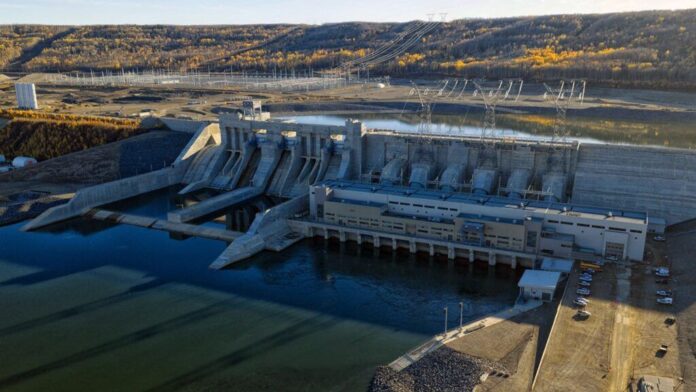B.C. Hydro is blaming the outsized costs for the Site C dam construction on a series of “low probability, high consequence” events, and said it should have done a better job preparing for those risks.
In a report to the British Columbia Utilities Commission about the lessons learned from the project, the Crown corporation said the construction was “more complex and challenging than BC Hydro and its contractors anticipated.”
Site C is the third dam and on the Peace River in northeastern B.C., located about seven kilometres from Fort St. John. The utility cites the complex geology of the site and wide swings in temperature during winter, often reaching lows of -30 degrees Celsius.
The dam came into full operation in August, producing enough power for about 450,000 homes.
The provincial government gave the project the greenlight in December 2014, with a budget of more than $8 billion. Since then, the cost has nearly doubled.
The report, released late last week, said B.C. Hydro and its contractors faced difficulties from the outset due to the large size and complexity of the project. It said internal resources should have been scaled up more proactively and sooner.
It said the first budget increase in 2018 was partly due to tension cracks on the left bank that led to schedule delays and about $610 million in additional costs.
In 2021, the province revised its cost estimate for Site C to $16 billion, and pushed the expected in-service date back one year to 2025.
The report said much of that budget increase was due to geotechnical challenges on the right bank and further delays caused by the COVID-19 pandemic.
While extensive geotechnical studies were conducted for decades leading up to the start of the project in 2024, B.C. Hydro had deemed the risk of major geotechnical challenges to be low and didn’t account for them in the initial budget.
When construction did run into such challenges, the COVID-19 pandemic only worsened the impacts on the project’s schedule and price tag. B.C. Hydro said pandemic-related slowdowns and delays added about $1.6 billion to the budget, while the enhancements to the right bank foundation added another $1.1 billion.
There were also additional costs for project resources, design changes, highway expansion and more.
The B.C. Hydro report said the project is on track to be completed within the latest budget, saying $14.5 billion had been spent as of June 2025.
The utility said other lessons to be learned from the project include the difficulty of working with multi-national consortiums. It said it took time for some to “fully appreciate the complexity of the Project and the challenges of working in northern British Columbia.”
The B.C. Hydro report lauds the efficiency of the project’s leadership team, though it notes “opportunities were identified to improve governance and oversight” in the early years of the project.
B.C. Hydro also lists “Indigenous Relations and Economic Opportunities” among the projects successes. It said 23 per cent of vendors involved in the project were Indigenous affiliated. It also touts eight impact benefit agreements signed with First Nations and the establishment of a fund to support cultural and research projects.
The project faced significant opposition from communities in Treaty 8 territory.
A 2014 report by a joint review panel found that the project would likely cause a
“significant adverse effect” on fishing opportunities and practices for the First Nations in the area.
In 2022, the province, Canada and B.C. Hydro came to a negotiated settlement with West Moberly First Nation after a decades-long legal fight.
“The Site C project has had major impacts on our community, and the flooding and operation of this dam will have effects that will be felt for generations to come,” said Chief Roland Willson following the settlement.
B.C. Hydro said Site C has performed well since it began ramping up operations about a year ago, including continuous operation of the spillway throughout last winter.
The reservoir’s public boat launches are expected to remain closed until at least spring 2026, while B.C. Hydro monitors slope stability and shoreline erosion in the area.
The post B.C. Hydro cites unforeseen risks for Site C dam cost overruns appeared first on AM 1150.




